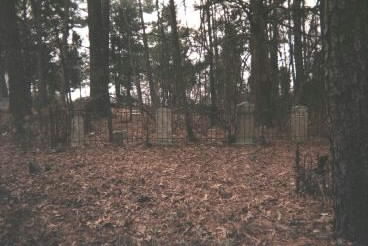Erwin Mills Cemetery
Grave Site Cleanup Sheds Light on Past
65 people cleared truckloads of brambles and saplings from the old Erwin Mills cemetery.
By Paul Bonner
Reprinted with permission from the Durham
Herald-Sun (March 5, 2000).
[Pictures courtesy of OWDNA]

What started as one man's quest for his grandfather's
gravesite brought scores of volunteers Saturday to the long-neglected
resting place of the people who built West Durham.
About 65 people worked all morning with chain saws, axes and their hands, clearing away truckloads of brambles and saplings from the old Erwin Mills cemetery. The effort was organized by the Old West Durham Neighborhood Association. Bill Yarbrough of Chesapeake, Va., sought the headstone of his grandfather, Edward, who spelled the name Yarborough and reportedly was buried in 1936 in the cemetery for employees of the old cotton mill. He didn't find it.
But other descendants of mill workers found and cleaned up their forebears' graves, like that of Irene, wife of W.H. Cole, whose headstone stood surrounded by a small iron fence near the gravel road that passes the site, off LaSalle Street, just south of the railroad line through town. They also found daffodils blooming untended as they had for generations. Their seasonal reappearance after the cemetery had been all but abandoned for decades impressed John Schelp as symbolic, and he suggested that the neighborhood plant more there.
"We knew there was a cemetery here," said Schelp, president of the neighborhood association, by way of explaining how the idea for the cleanup took root and grew. "But not many people knew much about it."
"We knew there was a cemetery here," said Schelp, president of the neighborhood association, by way of explaining how the idea for the cleanup took root and grew. "But not many people knew much about it." Schelp found something else that he recognized from having seen something similar half a world away. He scanned the ground, thickly carpeted with fallen leaves, until he found a small patch of white. He bent down and brushed away the leaves to reveal a dozen or so weathered but well-preserved white seashells, large whelks, lying together on the ground. Just like in cemeteries in the African Congo, he said, where he had lived more than 20 years earlier as a Peace Corps worker. "Every time you'd come and visit, you'd leave a shell," he said. Last fall, when he first spotted the shells, he started researching his hunch - that there, in West Durham, an ancient African burial custom had persisted in the 20th century. Sure enough, he found death certificates for blacks buried in the Erwin Mills cemetery. Perhaps even more unusual, they lay buried beside whites at a time when even graveyards usually were strictly segregated by race.


Yarbrough's quest started last fall, when he was looking through some old papers belonging to his late mother. Among them were yellowed newspaper fragments containing Edward Yarborough's obituary. Yarbrough found clues in them: Durham and the Erwin cotton mill cemetery. He did a little Web surfing, found Old West Durham's site and dispatched an e-mail to Schelp. Schelp replied and started inquiring among older residents, like John McDonald of McDonald's Drug Store on Ninth Street. Eventually, he discovered that the cemetery was begun the same year as the mill and Trinity College, now Duke East Campus, 1893, dated by the earliest headstone date. The most recent ones are from the 1990s. Most of the headstones are modest marble and granite markers. Some are homemade, of field stone or the two upended concrete downspout splash blocks that bear indecipherable traces of paint.

"I think we are inspired to have another cleanup," Schelp said. "I feel great now," Yarbrough said. "You can see the headstones." Even though his grandfather's wasn't among them, he was satisfied. "It makes me feel good that people still care," he said.

Bill Yarbrough's search for the burial place of an
ancestor helped prompt a neighborly act in Durham. Yarbrough, of Chesapeake,
Va., had wanted to find the headstone for his grandfather, Edward H.
Yarbrough, whom he believed to be buried in the old Erwin Mills Cemetery.
Yarbrough contacted the Web site of the Old West Durham neighborhood
Association. The association's president, John Schelp, picked up on
the e-mail and began a search of his own. Yarbrough visited in November, and he, Schelp and other
members of the neighborhood association began planning a clean-up of
the Erwin Mills Cemetery. Last Saturday, about 65 people -- many of
them descendants of people buried in the cemetery, -- cleared brush
and brambles from the historic cemetery. There's a happy ending to Yarbrough's search. In a
letter to the editor published Friday, he said that a Durham woman,
after reading news coverage of the clean-up, called Schelp and advised
him of a survey she had worked on in the 1980s documenting the sites
in the cemetery. She found record of Crittie Florence Yarbrough, wife
of Edward H. Yarbrough, buried in th Bill Yarbrough's confirmation all came because Schelp
chose not to ignore his e-mail. We bestow upon Schelp, the Old West
Durham Neighborhood Association and all who cleaned up Erwin Mills Cemetery
our Durham Grit Award. Durham Herald Company, Inc.
Recent Updates - Summer 2019
Over the past two years, Old West neighbors have held several
clean up events to rejuvenate the Erwin Mills Cemetery. Working in conjunction with
Keep Durham Beautiful, tremendous progress has been made in clearing brush and debris
and ensuring that loved ones and history buffs can still gain access to this special piece
of property. More clean ups are planned, so stay tuned to the Old West Durham list serve
for announcements. Contribute an hour or up to half a day and come away with a sense of satisfaction
and an appreciation of the history of our little neighborhood.